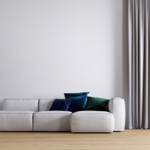Alan Davie 1920-2014
Snail Elements, 1956
Oil on canvas
122 x 152 cms
48 1/16 x 59 13/16 ins
48 1/16 x 59 13/16 ins
1348
Sold
Snail Elements was painted at one of the most crucial moments in the artist's development. In 1956, Davie exhibited in New York for the first time, where his work was...
Snail Elements was painted at one of the most crucial moments in the artist's development. In 1956, Davie exhibited in New York for the first time, where his work was acquired by major collections such as the Museum of Modern Art. While there Davie met many of the most important artists of the New York School, including Jackson Pollock and Willem de Kooning. Snail Elements suggests the legacy of Surrealist automatism and of a Cubist handling of space and in doing so parallels the inspiration such sources provided to young American painters. Viewed in this way Davie's painting may be compared not only to the all-over handling to be found in the drip paintings of Jackson Pollock but also to the types of embedded imagery and Jungian symbols to be found in his major paintings of the 1940s, as well as the spatial sophistication of de Kooning's paintings.
Snail Elements also exemplifies a response to Cubism found in Britain at this moment in which parity was given to form and content, as articulated by Patrick Heron: 'Cubism, in its love of the concrete, extols paint, canvas, paper, chalk as well as wine-glasses, tables and guitars. This sensuous love of the material is of paramount importance to Soulages, de Stael and -over here in England - to William Scott, Alan Davie, Roger Hilton, Peter Lanyon, Victor Pasmore and Terry Frost.' 'Space in Contemporary Painting and Architecture in Patrick Heron', The Changing Forms of Art (Routlege and Kegan Paul, London, 1955).
Related paintings are to be found in the collections of the Tate Gallery in London and the Scottish National Gallery of Modern Art in Edinburgh.are grateful to Alan Davie for his assistance in cataloguing this work.
Snail Elements also exemplifies a response to Cubism found in Britain at this moment in which parity was given to form and content, as articulated by Patrick Heron: 'Cubism, in its love of the concrete, extols paint, canvas, paper, chalk as well as wine-glasses, tables and guitars. This sensuous love of the material is of paramount importance to Soulages, de Stael and -over here in England - to William Scott, Alan Davie, Roger Hilton, Peter Lanyon, Victor Pasmore and Terry Frost.' 'Space in Contemporary Painting and Architecture in Patrick Heron', The Changing Forms of Art (Routlege and Kegan Paul, London, 1955).
Related paintings are to be found in the collections of the Tate Gallery in London and the Scottish National Gallery of Modern Art in Edinburgh.are grateful to Alan Davie for his assistance in cataloguing this work.
Provenance
The artistGimpel Fils


